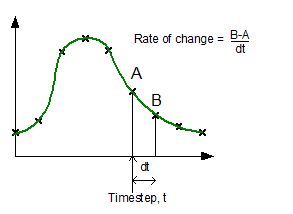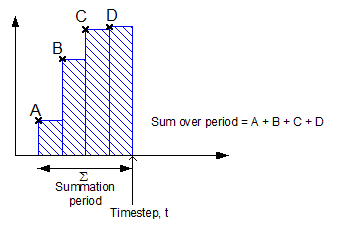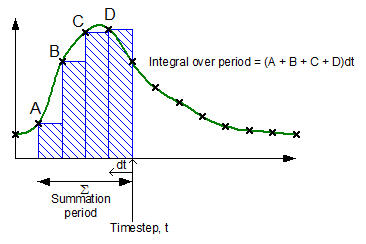ICMLive functionality is only available if the ICMLive option is enabled on your licence.
This database item is a collection of alert definitions used to alert the user about interesting occurrences in both the data coming from external sources (e.g. SCADA/telemetry or RADAR) and the simulation results. It can also be used to provide an alert to indicate that data may be missing in a TSD data stream using information from the simulation results log files.
Alert definition lists use information from simulation results, so it is advisable to have these open when defining alerts. Alert definitions, which are based on TSD objects, can also use information from a network with a TSD object dropped on to it.
Alert definition lists must be validated before any alert instances can be generated.
For an alert definition list to be used in ICMLive, it must be attached to a Manifest object. In manifests, alert definition lists can be used as:
- Default alert definition list - the list of alerts to be used in a run.
- Verification alert definition lists - the list of alerts to be used for a verification of a run. These are automated observed runs that occur between scheduled full runs. The verification alert definition list can be used to raise alerts if observed data deviates from the most recent full model run.
The alert definition list consists of a grid containing alert definitions.

See below for a description of the grid. See Working with Alert Definition Lists for details about how to use the grid, and for an example of using an SQL SPATIAL search in an alert definition list.
Grid description
|
Field |
Description |
||||||||||
|---|---|---|---|---|---|---|---|---|---|---|---|
|
Alert definition ID |
A unique name for the alert definition. The ID should contain only alphanumeric characters, numbers and the “_” character (no spaces allowed). |
||||||||||
|
Priority |
An integer that indicates how important the alert is. |
||||||||||
| Category |
Describes the alert (e.g. rainfall, pump, etc) and can be used to define an Full model runs trigger or a Variant runs trigger in the manifest. |
||||||||||
|
Target type A |
Dropdown of all object and data types for which alerts can be set (network objects, TVD connectors, TSD reports, 2D results - see Alerts for more information) as well as an <EXPRESSION> entry. Free text can be entered. The Scalar TSD report and Spatial TSD report options can be used to set an alert based on time series data summary results from the simulation results log files. The <EXPRESSION> option should be used to specify that the alert definition is to be a logical combination of other sub-alert definitions (see column Target expression A below for more details). |
||||||||||
|
Target A |
Dropdown providing either the names of time series data streams (if Target type A is set to either Scalar TSD report or Spatial TSD report) or a list of all relevant objects, with the addition of <ALL> and <SELECTION LIST>. Free text can be entered. <ALL> - alert definition will be applied to all objects of the type selected in Target type A. <SELECTION LIST> - alert definition will be only be applied to objects present in the selection list specified in Target selection list A. |
||||||||||
|
Target field A |
If Target type A is set to Scalar TSD report or Spatial TSD report, the dropdown contains the items in the report that you can set the alert for. For Scalar TSD reports, these are Status, Percentage_complete_in_hindcast, Percentage_complete_in_forecast and Latest_value; while for Spatial TSD reports, the options are Missing_image_count and Used_image_count. For all other items, the dropdown contains all potential time-varying values (results fields or observed fields) associated with the object(s) selected in Target A. It is also possible to:
|
||||||||||
|
Target selection list A |
Enabled when the <SELECTION LIST> option has been selected in the Target A field. Clicking
Note: Any object present in the selection list that is of a different type to the type specified in the Target type A field of the alert definition will automatically be filtered out by
InfoWorks ICM.
|
||||||||||
|
Target expression A |
Enabled when the <EXPRESSION> option has been selected in the Target type A field. Clicking
Expressions can be used to specify alert combinations or complex alerts. See Text Editor for details. |
||||||||||
|
Target SQL prefix A |
Enabled when the <SQL> option has been selected in the Target field A field. Clicking
This field is used to insert raw SQL text that, for example, creates variables based on other network objects. These other network objects can in turn be referred to in the body of the main SQL text (see Target SQL body A below). See Text Editor for details. Tip: It is highly recommended to build SQL queries using the
SQL dialog prior to pasting them into the Target SQL prefix A dialog. The SQL dialog contains powerful tools in terms of query building (lookup fields) and testing.
|
||||||||||
|
Target SQL body A |
Enabled when the <SQL> option has been selected in the Target field A field. Clicking
This field is used to specify SQL queries which will contain the criteria on which an actual alert instance will be generated. See Text Editor for more information. Tip: It is highly recommended to build SQL queries using the
SQL dialog prior to pasting them into the Target SQL body A dialog. The SQL dialog contains powerful tools in terms of query building (lookup fields) and testing.
|
||||||||||
| Peak value A |
Disabled when:
Determines whether or not the peak value data (peak value, units and time) for the event that triggered the alert is included in the alert instance list. You can choose to include the maximum or minimum peak value, or leave the field blank (empty). If blank (default), the peak value data will not be included in the alert instance list. |
||||||||||
|
Comparison operator |
Enabled when:
Available operators are:
> will flag if Target Value A > Target Value B < will flag if Target Value A < Target Value B AbsDiff< will flag if Abs(Target Value A - Target Value B) < Tolerance AbsDiff> will flag if Abs(Target Value A - Target Value B) > Tolerance |
||||||||||
|
Target type B |
Dropdown of all network object types for which alerts can be set as well as TVD connectors, 2D results and alerts. In addition, a <FIXED VALUE> option has been included to allow the simulation result or the Scalar or Spatial TSD summary report item in the selected data stream to be compared with a constant value. Setting Target type B to a network object type with Target B and Target field B filled in appropriately, allows users to compare one simulation result against another simulation result (Target A.Target field A will be compared against the value of Target B.Target field B). It is worth mentioning that this also applies to SQL-based alert definitions (Target field A set to <SQL>). Note: This field cannot be an expression (no <EXPRESSION> option available).
|
||||||||||
|
Target B |
Dropdown of all relevant objects. Only one object can be selected (Target type B set to network object type) or one fixed value entered (Target type B set to <FIXED VALUE>) in this field. |
||||||||||
|
Target field B |
Unavailable when Target B is set to <FIXED VALUE>. Dropdown containing all potential time-varying values (results fields or observed fields) associated with the object(s) selected in Target B. It is also possible to:
|
||||||||||
|
Tolerance |
Available for Comparison operators AbsDiff< and AbsDiff>.
User-defined maximum permissible deviation. Disabled for Scalar/Spatial TSD reports. |
||||||||||
| Dead time |
The time after an alert instance has ended before the next event should be recorded as a new alert instance. If an alert instance occurs then it will only be considered to have finished when the dead time has been exceeded. The finish time of the alert instance will be set to the time at which the dead time period started, not the time at which it ended. The dead time must be of the form 10d4h30m, or 30m. Disabled for Scalar/Spatial TSD reports. |
||||||||||
|
Deadband |
The marginal region below the threshold level that the alert can fluctuate into whilst still being considered part of the same alert. The marginal region is defined relative to the threshold level, it is not an absolute value. Disabled for Scalar/Spatial TSD reports. |
||||||||||
|
Minimum duration |
The minimum amount of time that test criterion must be met before the occurrence is considered to be an alert. The minimum duration must be of the form 10d4h30m, or 30m. Disabled for Scalar/Spatial TSD reports. |
||||||||||
|
Transform |
Transformation to be applied. Available options are:
Disabled for Scalar/Spatial TSD reports. |
||||||||||
|
Summation period (hh:mm) |
Enabled when the Transform field is set to Sum Over Period or Integral over period. Period over which the results are summed. Its format is of the type 10d20h30m, 1m, 2d30m etc. Disabled for Scalar/Spatial TSD reports. |
||||||||||
|
Time window start |
(hh:mm relative to run origin. By default the run origin is the current local time or "now"). Start time of the window during which the alert is to be evaluated (no alert will be generated outside of the defined time window). Same format as Summation period. Disabled for Scalar/Spatial TSD reports. |
||||||||||
|
Time window end |
(hh:mm relative to run origin) End time of the window during which the alert is to be evaluated (no alert will be generated outside of the defined time window). Same format as Summation period. Disabled for Scalar/Spatial TSD reports. |
||||||||||
| Active window start |
Start time in hours and minutes (hh:mm) for the active period of the alert. Alert instances will be generated for any alerts which occur within the specified Active window start and the Active window end. That is, the defined alert will only have an instance generated if its onset time or end time is within the specified active time window, or it spans the active time window. Specifying an Active window start time that is greater than the specified Active window end time enables an active window to be set that spans into the next day. For example Active window start = 18:00 and Active window end = 08:00 ensures that any alert instances that occur between 6pm and 8am the next day will be recorded. |
||||||||||
| Active window end | End time in hours and minutes (hh:mm) for the active period of the alert. See the description of the Active window start for further information. | ||||||||||
|
Visibility |
Controls the visibility of the generated alert instances in InfoWorks ICM and ICMLive Operator Client. Available values are: Grid + Theme - alert instances visible in the Alert Instance Grid, and as a theme on the GeoPlan. Grid only - alert instances visible in the Alert Instance Grid only. Theme only - alert instances visible as a theme on the GeoPlan only. None - no visibility. Free text - user-defined. |
||||||||||
| Graph trace |
Applicable for an alert definition that includes a Comparison operator and has a Target type B set to <FIXED VALUE>. Displays a colour palette from which you can select a colour or choose a custom colour to be used as the trace for this alert definition on a results graph. If you choose a custom colour, a Windows Colours window is displayed from which you can select or define a custom colour. The selected trace colour will be used in results graphs in InfoWorks ICM and ICMLive Operator Client for the applicable alert definition. If you have set up any custom graphs in InfoWorks ICM that the alert would apply to, the selected colour will also be used for the alert threshold in custom graphs in ICMLive Operator Client if the applicable custom graphs are included in the graph export page of the manifest. The selected Graph trace colour will also be used for the alert threshold in any custom graphs included an action list. Disabled if Target type B is not set to <FIXED VALUE>. |
||||||||||
| Notes |
Any additional information about the alert that an operator may find useful is displayed in this field. The note will be included in the alert instance (if the Visibility is set for this) when an alert occurs. Notes can be added, edited, deleted or displayed in full by clicking
|

 displays the
displays the


